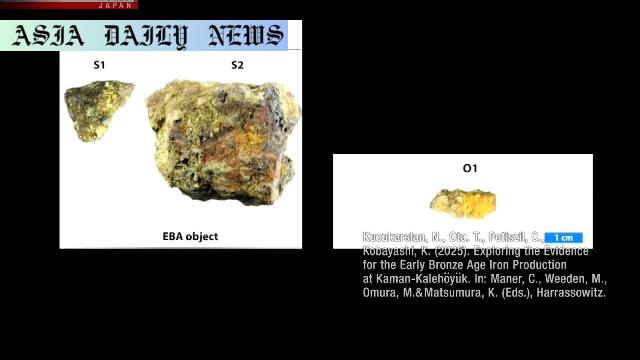Ironmaking: Bronze Age artifacts in Turkey reveal attempts at iron production 1,000 years before the Hittite Empire.

Introduction to the Groundbreaking Discovery
In an extraordinary archaeological breakthrough, a team of Japanese researchers from the Japanese Institute of Anatolian Archaeology has unearthed new insights into the origins of ironmaking. Working at the Kaman-Kalehoyuk ruins in central Turkey, the team discovered remnants of heated iron ore buried in a stratum dating back 4,200 years during the Bronze Age. This potentially shifts the timeline of iron production by nearly 1,000 years, preceding the well-documented ironworking dominance of the Hittite Empire.
The Fascinating Findings
Using advanced tools like electron microscopes, the archaeologists analyzed metal fragments measuring several centimeters. These tests revealed that two of the pieces were derived from heated iron ore, while one was identified as artificial iron. The discovery of these materials suggests that early civilizations were experimenting with techniques similar to those used for smelting copper and bronze, attempting to create iron far earlier than previously believed.
Significance of the Kaman-Kalehoyuk Ruins
The Kaman-Kalehoyuk site has been a focal point for archaeological research for over 40 years, providing a wealth of data on ancient Anatolian civilizations. Situated at the crossroads of significant trade routes, the area has historically been a melting pot of culture and technology. Unearthing artifacts such as the heated iron ore amidst other relics from the Bronze Age highlights the interconnectedness and innovation of ancient societies, especially in the realm of metallurgy.
The Role of Furnaces in Early Ironmaking
One of the most intriguing aspects of this discovery is the remains of about 10 furnaces found in the same stratum as the heated iron ore. These furnaces potentially indicate an intentional effort to produce iron through methods adapted from copper and bronze smelting processes. The research team plans to conduct further analysis to confirm whether these furnaces served as the birthplace of ironworking technology.
Implications for the History of Metallurgy
Iron production is often associated with the Iron Age, a period beginning around 1200 BCE when iron tools and weapons became widespread. However, these findings from Kaman-Kalehoyuk challenge conventional timelines, suggesting that innovations in ironmaking were underway well before this era. The evidence supports the notion that experimentation with metallurgy was a significant factor in the technological development of ancient civilizations.
The Broader Historical Context
During the Bronze Age, civilizations were primarily focused on the production of bronze, an alloy of copper and tin. The transition to iron was a monumental leap that required overcoming technical challenges, such as higher production temperatures. The discovery at Kaman-Kalehoyuk shows that this transition may have been more gradual and experimental than previously thought, with early attempts laying the groundwork for later successes during the Hittite Empire and beyond.
Future Research Plans
Omura Sachihiro, the lead archaeologist, emphasized that this discovery is just the beginning. The team plans to conduct an in-depth study of the unearthed furnaces, aiming to establish their exact role in early iron production. They also intend to collaborate with metallurgists and historians to reconstruct the techniques and processes used by these ancient pioneers. Their findings will be presented at the Tokyo National Museum on March 9, offering a comprehensive overview of this landmark discovery.
Conclusion: Redefining History
This discovery at Kaman-Kalehoyuk is a testament to the ingenuity and curiosity of ancient civilizations. By revealing the early origins of ironmaking, it underscores the importance of archaeological research in reshaping our understanding of history. As more evidence comes to light, the story of humanity’s technological evolution continues to grow richer and more complex.
Commentary
A New Chapter in Archaeological Discoveries
The recent findings at Kaman-Kalehoyuk are nothing short of groundbreaking. They represent a pivotal moment in our understanding of how ironmaking began and how ancient civilizations pushed the boundaries of technological innovation. To think that early metallurgists were experimenting with iron nearly a millennium before the Hittites is truly awe-inspiring. Such discoveries remind us of the ingenuity and resourcefulness of our ancestors.
The Importance of Multidisciplinary Research
I am particularly struck by the interdisciplinary approach taken by Omura Sachihiro and his team. Using modern tools like electron microscopes to analyze ancient materials adds a layer of precision and reliability to archaeological methods. This combination of ancient site excavation and advanced technology exemplifies how archaeology is evolving as a field, offering us deeper insights into the past.
Shaping Our Historical Understanding
As a history enthusiast, I find the implications of this discovery incredibly exciting. It provides a more nuanced understanding of how civilizations from the Bronze Age to the Iron Age developed their technological capabilities. The gradual transition from copper and bronze to iron showcases humanity’s intrinsic drive to innovate and adapt. These small pieces of iron ore have immense historical value, shedding light on a critical turning point in human progress.
Looking Ahead
I am eagerly anticipating the detailed report from the Tokyo National Museum on March 9. These findings could open the door to similar research at other sites, offering a broader perspective on the origins of ironmaking across different cultures. As we uncover more about our shared human history, we learn not only about ancient innovations but also about the resilience and creativity that define us as a species.


